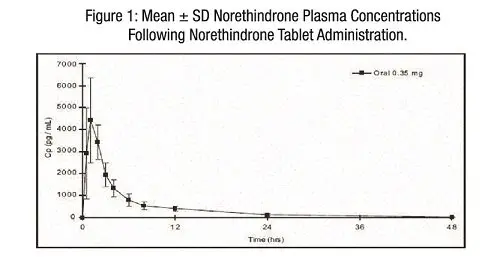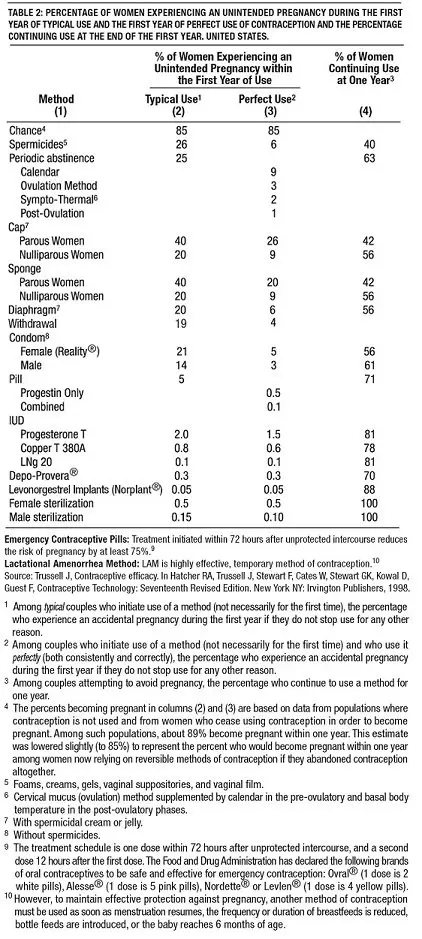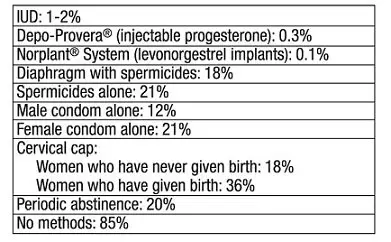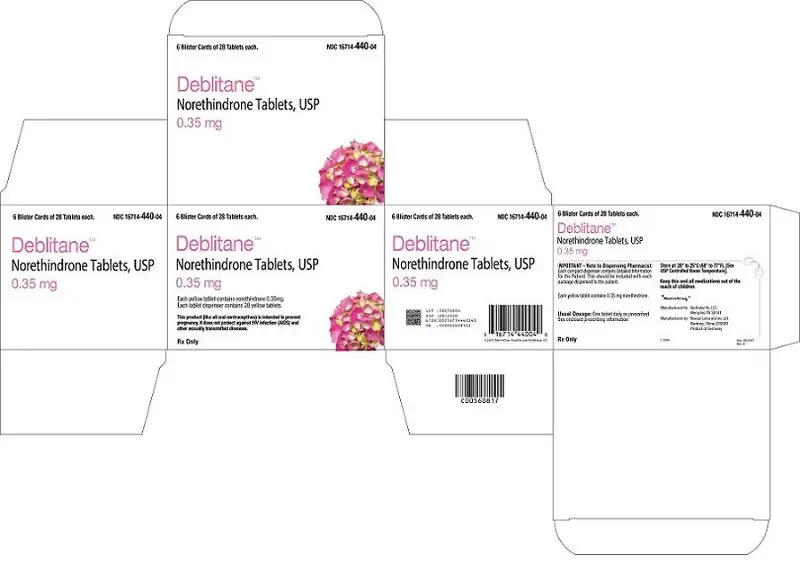Drug Detail:Deblitane (Norethindrone [ nor-eth-in-drone ])
Drug Class: Contraceptives Progestins
PHYSICIAN LABELING
Patients should be counseled that oral contraceptives do not protect against transmission of HIV (AIDS) and other sexually transmitted diseases (STDs) such as Chlamydia, genital herpes, genital warts, gonorrhea, hepatitis B, and syphilis.
WARNING
Cigarette smoking increases the risk of serious cardiovascular side effects from oral contraceptive use. This risk increases with age and with heavy smoking (15 or more cigarettes per day) and is quite marked in women over 35 years of age. Women who use oral contraceptives should be strongly advised not to smoke.
Deblitane Description
DEBLITANE (Norethindrone tablets, USP). Each yellow, biconvex, round tablet debossed with "K2" on one side contains 0.35 mg norethindrone. Inactive ingredients include polyvinyl alcohol, titanium dioxide, talc, macrogol/polyethylene glycol 3350 NF, D&C Yellow No. 10 Aluminum Lake, lecithin (soya), FD&C Red No. 40 Aluminum Lake, FD&C Blue No. 2 Aluminum Lake, lactose monohydrate, magnesium stearate, and pregelatinized starch.

Therapeutic class = oral contraceptive.
USP Dissolution Test is Pending
Deblitane - Clinical Pharmacology
2. Pharmacokinetics

Table 1 provides summary statistics of the pharmacokinetic parameters associated with single dose norethindrone tablets administration.

Distribution: Following oral administration, norethindrone is 36% bound to sex hormone binding globulin (SHBG) and 61% bound to albumin. Volume of distribution of norethindrone is approximately 4 L/kg.
Metabolism: Norethindrone undergoes extensive biotransformation, primarily via reduction, followed by sulfate and glucuronide conjugation; less than 5% of a norethindrone dose is excreted unchanged; greater than 50% and 20 to 40% of a dose is excreted in urine and feces, respectively. The majority of metabolites in the circulation are sulfate, with glucuronides accounting for most of the urinary metabolites.
Excretion: Plasma clearance rate for norethindrone has been estimated to be approximately 600 L/day. Norethindrone is excreted in both urine and feces, primarily as metabolites. The mean terminal elimination half-life of norethindrone following single dose administration of norethindrone tablet is approximately 8 hours.
Related/similar drugs
norethindrone, medroxyprogesterone, levonorgestrel, Provera, Depo-Provera, MirenaIndications and Usage for Deblitane
1. Indications. Progestin-only oral contraceptives are indicated for the prevention of pregnancy.
2. Efficacy. If used perfectly, the first-year failure rate for progestin-only oral contraceptives is 0.5%. However, the typical failure rate is estimated to be closer to 5%, due to late or omitted pills. The following table lists the pregnancy rates for users of all major methods of contraception.

Contraindications
- Known or suspected pregnancy
- Known or suspected carcinoma of the breast
- Undiagnosed abnormal genital bleeding
- Hypersensitivity to any component of this product
- Benign or malignant liver tumors
- Acute liver disease
Warnings
The physician should remain alert to the earliest manifestation of symptoms of any serious disease and discontinue oral contraceptive therapy when appropriate.
4. Carcinoma of the Breast and Reproductive Organs
Some studies suggest that oral contraceptive use has been associated with an increase in the risk of cervical intraepithelial neoplasia in some populations of women. However, there continues to be controversy about the extent to which such findings may be due to differences in sexual behavior and other factors. There is insufficient data to determine whether the use of POPs increases the risk of developing cervical intraepithelial neoplasia.
Precautions
3. Carbohydrate and Lipid Metabolism
Lipid metabolism is occasionally affected in that HDL, HDL2, and apolipoprotein A-I and A-II may be decreased; hepatic lipase may be increased. There is no effect on total cholesterol, HDL3, LDL, or VLDL.
4. Drug Interactions
Change in contraceptive effectiveness associated with coadministration of other products:
a. Anti-infective agents and anticonvulsants. Contraceptive effectiveness may be reduced when hormonal contraceptives are coadministered with antibiotics, anticonvulsants, and other drugs that increase the metabolism of contraceptive steroids. This could result in unintended pregnancy or breakthrough bleeding. Examples include rifampin, barbiturates, phenylbutazone, phenytoin, carbamazepine, felbamate, oxcarbazepine, topiramate, and griseofulvin.
b. Anti-HIV protease inhibitors. Several of the anti-HIV protease inhibitors have been studied with coadministration of oral contraceptives; significant changes (increase and decrease) in the plasma levels of the estrogen and progestin have been noted in some cases. The safety and efficacy of OC products may be affected with the coadministration of anti-HIV protease inhibitors. Health care providers should refer to the label of the individual anti-HIV protease inhibitors for further drug-drug interaction information.
c. Herbal products. Herbal products containing St. John's Wort (hypericum perforatum) may induce hepatic enzymes (cytochrome P450) and p-glycoprotein transporter and may reduce the effectiveness of contraceptive steroids. This may also result in breakthrough bleeding.
5. Interactions with Laboratory Tests
The following endocrine tests may be affected by progestin-only oral contraceptive use:
- Sex hormone-binding globulin (SHBG) concentrations may be decreased.
- Thyroxine concentrations may be decreased, due to a decrease in thyroid binding globulin (TBG).
11. Gastrointestinal
Diarrhea and/or vomiting may reduce hormone absorption resulting in decreased serum concentrations.
INFORMATION FOR THE PATIENT
1. See PATIENT LABELING for detailed information.
2. Counseling issues. The following points should be discussed with prospective users before prescribing progestin-only oral contraceptives:
- The necessity of taking pills at the same time every day, including throughout all bleeding episodes.
- The need to use a backup method such as condoms and spermicides for the next 48 hours whenever a progestin-only oral contraceptive is taken 3 or more hours late.
- The potential side effects of progestin-only oral contraceptives, particularly menstrual irregularities.
- The need to inform the clinician of prolonged episodes of bleeding, amenorrhea or severe abdominal pain.
- The importance of using a barrier method in addition to progestin-only oral contraceptives if a woman is at risk of contracting or transmitting STDs/HIV.
Adverse Reactions/Side Effects
- Menstrual irregularity is the most frequently reported side effect.
- Frequent and irregular bleeding are common, while long duration of bleeding episodes and amenorrhea are less likely.
- Headache, breast tenderness, nausea, and dizziness are increased among progestin-only oral contraceptive users in some studies.
- Androgenic side effects such as acne, hirsutism, and weight gain occur rarely.
Overdosage
There have been no reports of serious ill effects from overdosage, including ingestion by children.
How is Deblitane supplied
DEBLITANE Tablets are available in the following configurations:
Carton of 1 NDC 16714-440-02
Carton of 3 NDC 16714-440-03
Carton of 6 NDC 16714-440-04
STORAGE
Store at 20° to 25°C (68° to 77°F). [See USP Controlled Room Temperature.]
SPL PATIENT PACKAGE INSERT
DETAILED INFORMATION FOR THE PATIENT
Patients should be counseled that oral contraceptives do not protect against transmission of HIV (AIDS) and other sexually transmitted diseases (STDs) such as Chlamydia, genital herpes, genital warts, gonorrhea, hepatitis B, and syphilis.
INTRODUCTION
This leaflet is about birth control pills that contain one hormone, a progestin. Please read this leaflet before you begin to take your pills. It is meant to be used along with talking with your doctor or clinic.
Progestin-only pills are often called "POPs" or "the minipill." POPs have less progestin than the combined birth control pill (or "the pill") which contains both an estrogen and a progestin.
HOW EFFECTIVE ARE POPS?
About 1 in 200 (0.5%) POPs users will get pregnant in the first year if they all take POPs perfectly (that is, on time, every day). About 1 in 20 (5%) "typical" POPs users (including women who are late taking pills or miss pills) gets pregnant in the first year of use. The following table will help you compare the efficacy of different methods.

- They make the cervical mucus at the entrance to the womb (the uterus) too thick for the sperm to get through to the egg.
- They prevent ovulation (release of the egg from the ovary) in about half the time.
- They also affect other hormones, the fallopian tubes and the lining of the uterus.
- If there is any chance you may be pregnant.
- If you have breast cancer.
- If you have bleeding between your periods which has not been diagnosed.
- If you are taking certain drugs for epilepsy (seizures) or for TB. (See USING POPSWITH OTHER MEDICINES below.)
- If you are hypersensitive or allergic to any component of this product.
- If you have liver tumors, either benign or cancerous.
- If you have acute liver disease.
WARNING: If you have sudden or severe pain in your lower abdomen or stomach area, you may have an ectopic pregnancy or an ovarian cyst. If this happens, you should contact your doctor or clinic immediately.
1. Ectopic pregnancy. An ectopic pregnancy is a pregnancy outside the womb. Because POPs protect against pregnancy, the chance of having pregnancy outside the womb is very low. If you do get pregnant while taking POPs, you have a slightly higher chance that the pregnancy will be ectopic than do users of some other birth control methods.
2. Ovarian cysts. These cysts are small sacs of fluid in the ovary. They are more common among POP users than among users of most other birth control methods. They usually disappear without treatment and rarely cause problems.
3. Cancer of the reproductive organs and breasts. Some studies in women who use combined oral contraceptives that contain both estrogen and a progestin have reported an increase in the risk of developing breast cancer, particularly at a younger age and apparently related to duration of use. There is insufficient data to determine whether the use of POPs similarly increases this risk.
Some studies have found an increase in the incidence of cancer of the cervix in women who use oral contraceptives. However, this finding may be related to factors other than the use of oral contraceptives and there is insufficient data to determine whether the use of POPs increases the risk of developing cancer of the cervix.
4. Liver tumors. In rare cases, combined oral contraceptives can cause benign but dangerous liver tumors. These benign liver tumors can rupture and cause fatal internal bleeding. In addition, a possible but not definite association has been found with combined oral contraceptives and liver cancers in studies in which a few women who developed these very rare cancers were found to have used combined oral contraceptives for long periods of time. There is insufficient data to determine whether POPs increase the risk of liver tumors.
SEXUALLY TRANSMITTED DISEASES (STDS)
WARNING: POPs do not protect against getting or giving someone HIV (AIDS) or any other STD, such as Chlamydia, gonorrhea, genital warts or herpes.
SIDE EFFECTS
1. Irregular bleeding. The most common side effect of POPs is a change in menstrual bleeding. Your periods may be either early or late, and you may have some spotting between periods. Taking pills late or missing pills can also result in some spotting or bleeding.
2. Other side effects. Less common side effects include headaches, tender breasts, nausea and dizziness. Weight gain, acne and extra hair on your face and body have been reported, but are rare.
If you are concerned about any of these side effects, check with your doctor or clinic.
USING POPS WITH OTHER MEDICINES
Before taking a POP, inform your health care provider of any other medication, including over-the-counter medicine, that you may be taking.
If you are taking medicines for seizures (epilepsy) or tuberculosis (TB), tell your doctor or clinic. These medicines can make POPs less effective:
Medicines for seizures:
• Phenytoin (Dilantin® )
• Carbamazepine (Tegretol ®)
• Phenobarbital
Medicine for TB:
• Rifampin (Rifampicin)
Before you begin taking any new medicines be sure your doctor or clinic knows you are taking birth control pills that contain a progestin.
HOW TO TAKE POPS
| IMPORTANT POINTS TO REMEMBER
|
- POPs must be taken at the same time every day, so choose a time and then take the pill at the same time every day. Every time you take a pill late, and especially if you miss a pill, you are more likely to get pregnant.
- Start the next pack the day after the last pack is finished. There is no break between packs. Always have your next pack of pills ready.
- You may have some menstrual spotting between periods. Do not stop taking your pills if this happens.
- If you vomit soon after taking a pill, use a backup method (such as condom and/or spermicide) for 48 hours.
- If you want to stop taking POPs, you can do so at any time, but, if you remain sexually active and don't wish to become pregnant, be certain to use another birth control method.
- If you are not sure about how to take POPs, ask your doctor or clinic.
| STARTING POPS
|
- It's best to take your first POP on the first day of your menstrual period.
- If you decide to take your first POP on another day, use a backup method (such as condom and/or spermicide) every time you have sex during the next 48 hours.
- If you have had a miscarriage or an abortion, you can start POPs the next day.
| IF YOU ARE LATE OR MISS TAKING YOUR POPS
|
• If you are more than 3 hours late or you miss one or more POPs:
1. TAKE a missed pill as soon as you remember that you missed it,
2. THEN go back to taking POPs at your regular time,
3. BUT be sure to use a backup method (such as condom and/or spermicide) every time you have sex for the next 48 hours.
• If you are not sure what to do about the pills you have missed, keep taking POPs and use a backup method until you can talk to your doctor or clinic.
| IF YOU ARE BREASTFEEDING
|
- If you are fully breastfeeding (not giving your baby any food or formula), you may start your pills 6 weeks after delivery.
- If you are partially breastfeeding (giving your baby some food or formula), you should start taking pills by 3 weeks after delivery.
| IF YOU ARE SWITCHING PILLS
|
- If you are switching from the combined pills to POPs, take the first POP the day after you finish the last active combined pill. Do not take any of the 7 inactive pills from the combined pill pack. You should know that many women have irregular periods after switching to POPs, but this is normal and to be expected.
- If you are switching from POPs to the combined pills, take the first active combined pill on the first day of your period, even if your POPs pack is not finished.
- If you switch to another brand of POPs, start the new brand anytime.
- If you are breastfeeding, you can switch to another method of birth control at any time, except do not switch to the combined pills until you stop breastfeeding or at least until 6 months after delivery.
| PREGNANCY WHILE ON THE PILL
|
You should get a pregnancy test:
- If your period is late and you took one or more pills late or missed taking them and had sex without a backup method.
- Anytime you miss 2 periods in a row.
| WILL POPS AFFECT YOUR ABILITY TO GET PREGNANT LATER?
|
| BREASTFEEDING
|
| OVERDOSE
|
OTHER QUESTIONS OR CONCERNS
If you have any questions or concerns, check with your doctor or clinic. You can also ask for the more detailed "professional package labeling" written for doctors and other health care providers.
HOW TO STORE YOUR POPS
Store at 20° to 25°C (68° to 77°F). [See USP Controlled Room Temperature.]
This product's label may have been updated. For current package insert and further product information, contact Northstar Rx LLC toll-free at 1-800-206-7821.
To report SUSPECTED ADVERSE REACTIONS, contact Northstar Rx LLC. Toll-Free at 1-800-206-7821 or FDA at 1-800-FDA-1088 or www.fda.gov/medwatch.
Keep this and all medication out of the reach of children.
Northstar Rx LLC
Memphis, TN 38141
Manufactured by:
Novast Laboratories Ltd.
Nantong, China 226009
Iss. 09/2013
| DEBLITANE
norethindrone kit |
||||||||||||||||||||||||||||||||||||||||||||||||||
|
||||||||||||||||||||||||||||||||||||||||||||||||||
|
||||||||||||||||||||||||||||||||||||||||||||||||||
|
||||||||||||||||||||||||||||||||||||||||||||||||||
|
||||||||||||||||||||||||||||||||||||||||||||||||||
|
||||||||||||||||||||||||||||||||||||||||||||||||||
|
||||||||||||||||||||||||||||||||||||||||||||||||||
|
||||||||||||||||||||||||||||||||||||||||||||||||||
|
||||||||||||||||||||||||||||||||||||||||||||||||||
|
||||||||||||||||||||||||||||||||||||||||||||||||||
|
||||||||||||||||||||||||||||||||||||||||||||||||||
| Labeler - Northstar Rx LLC (830546433) |
| Registrant - Novast Laboratories, Ltd. (527695995) |
| Establishment | |||
| Name | Address | ID/FEI | Business Operations |
|---|---|---|---|
| Novast Laboratories, Ltd. | 527695995 | MANUFACTURE(16714-440) | |





